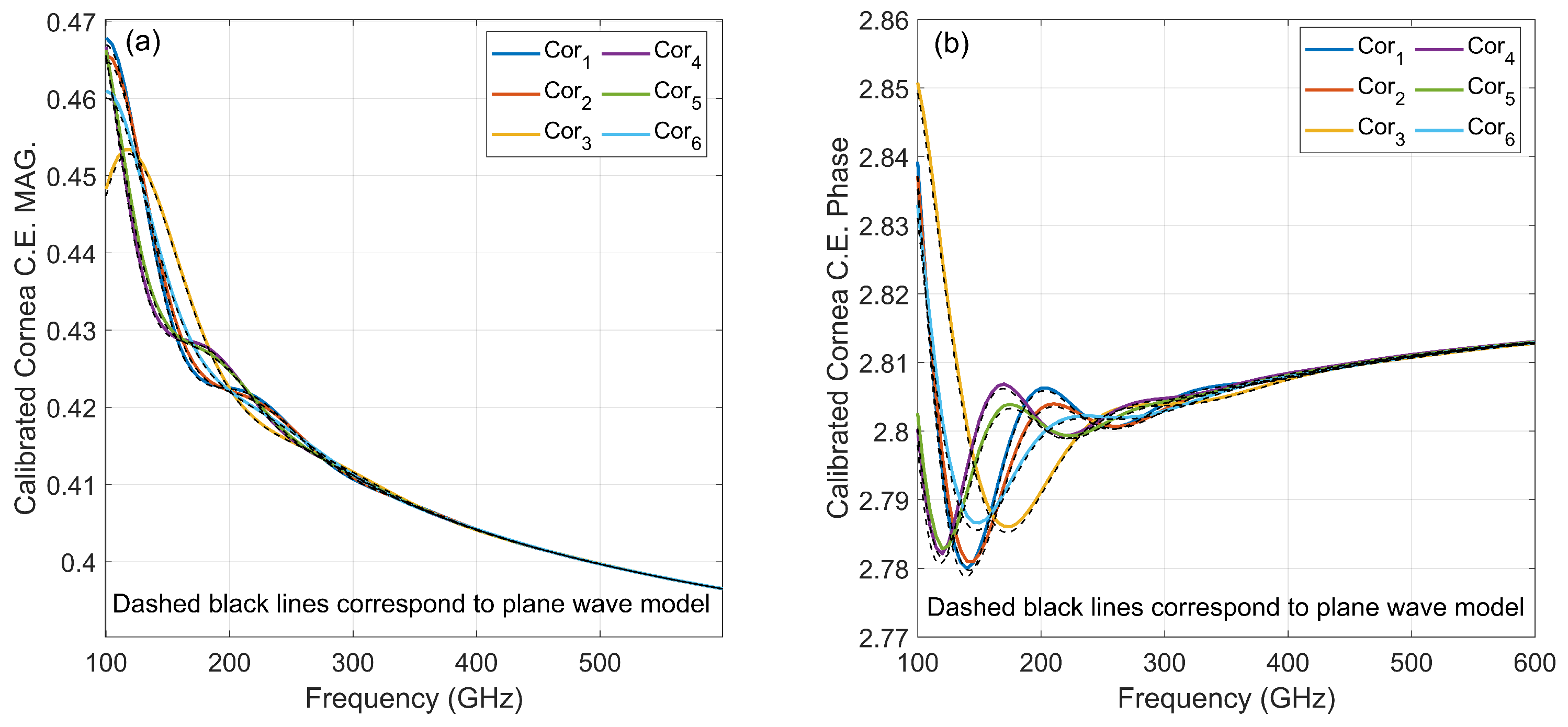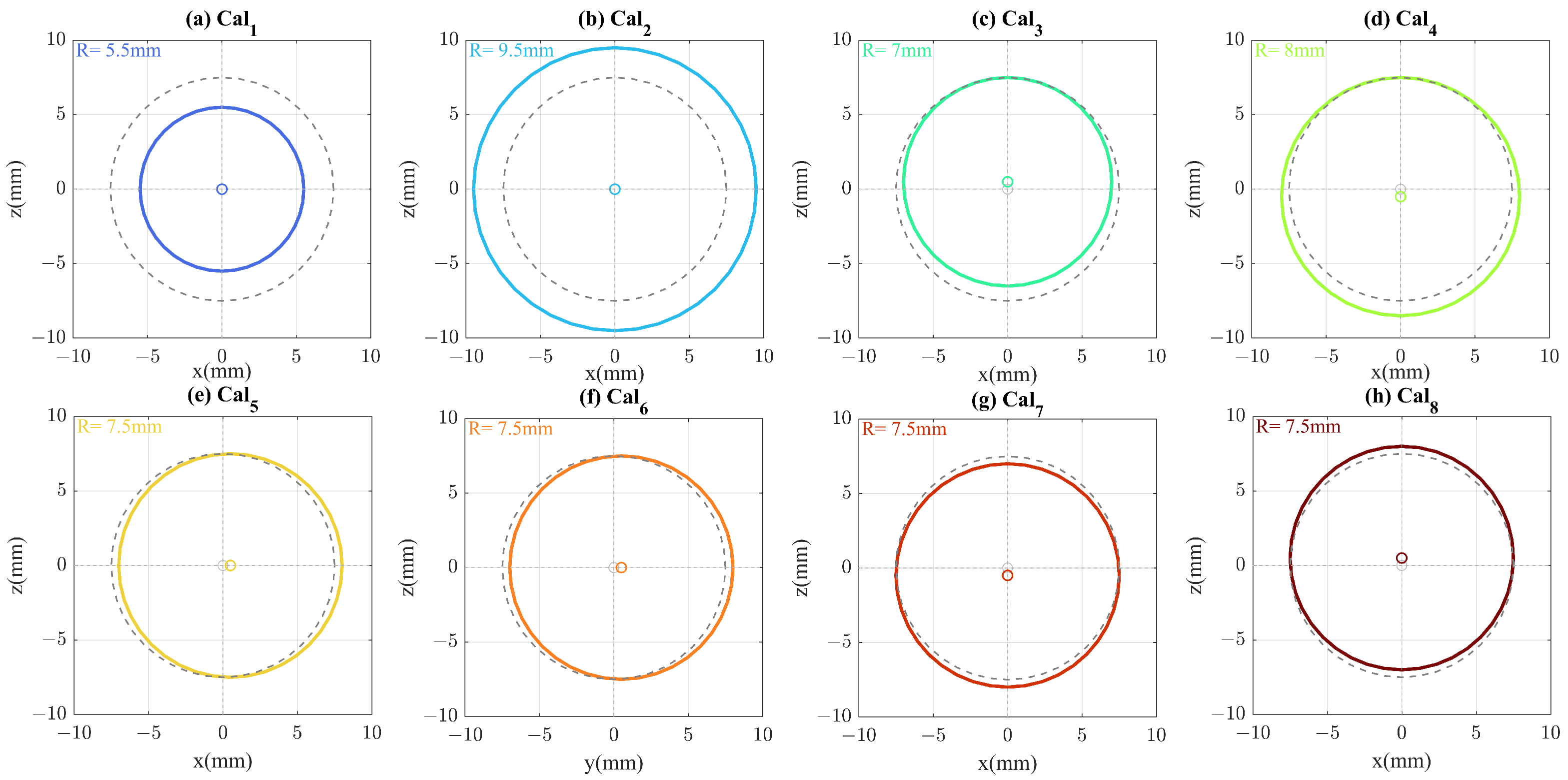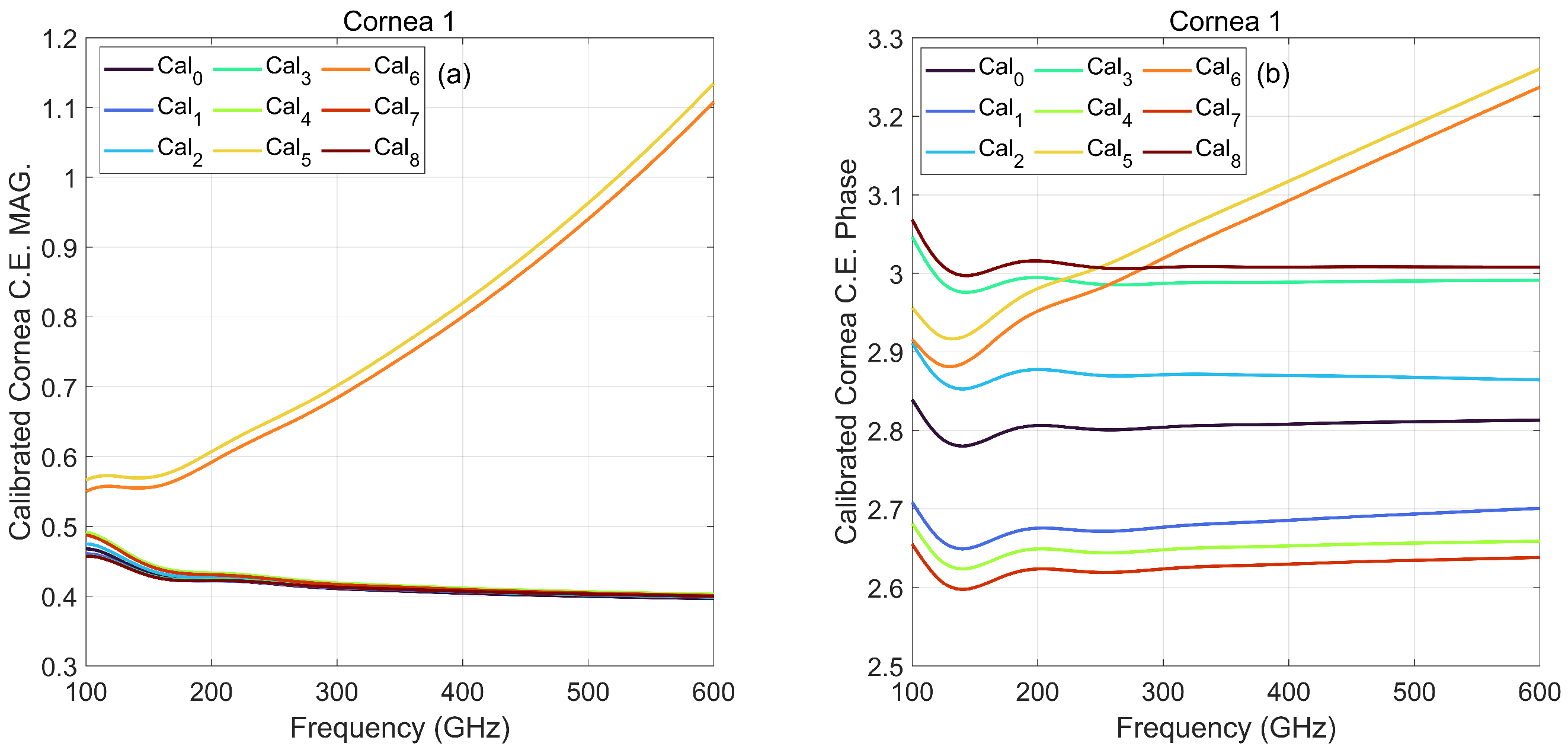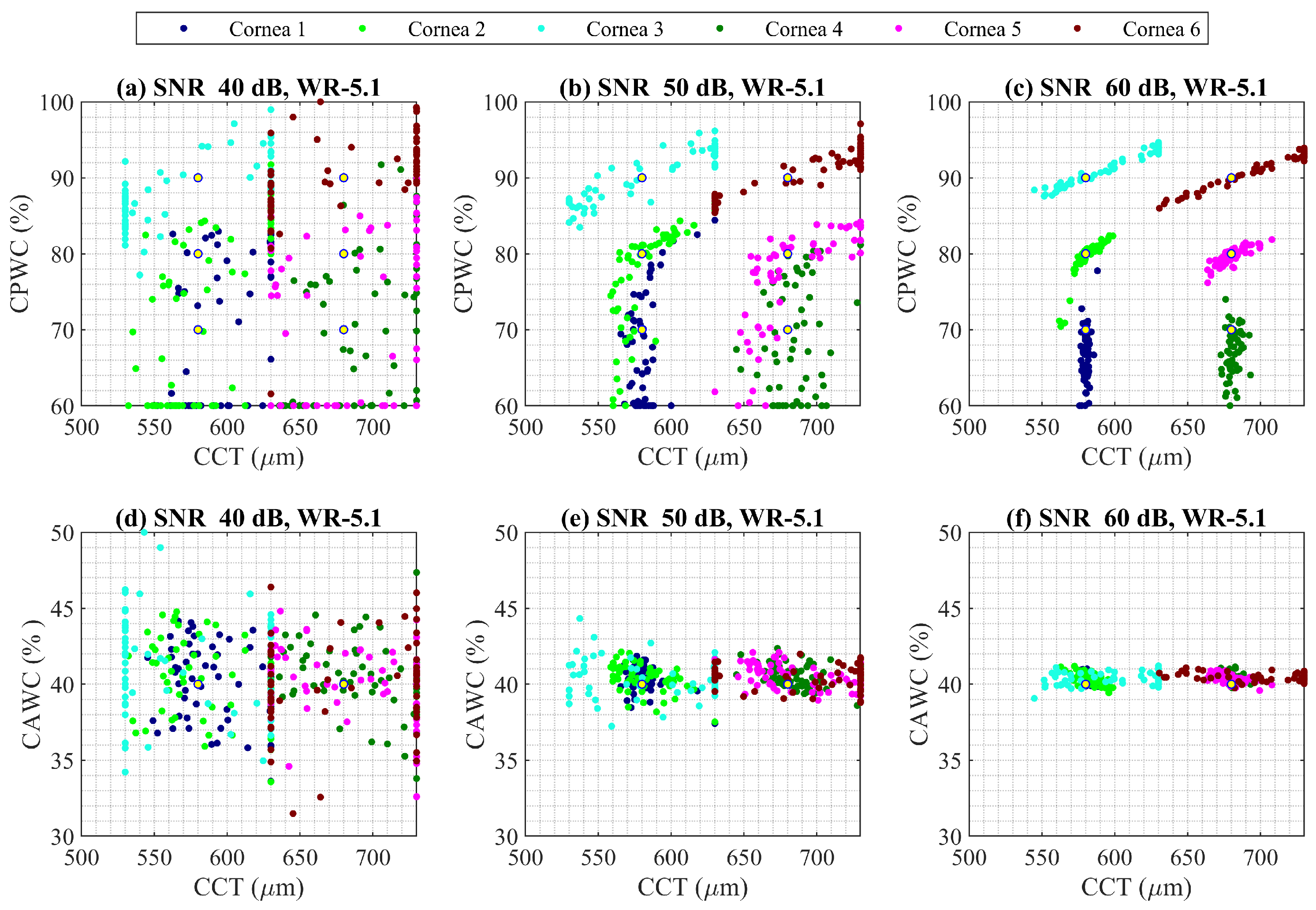Calibration Alignment Sensitivity in Corneal Terahertz Imaging
Abstract
:1. Introduction
2. Theory Based on Fourier Optic and Vector Spherical Harmonics
3. Cornea Calibration
3.1. Correctly Calibrated Cornea
3.2. Perturbed Calibrated Cornea
4. Extraction of Corneal Features
4.1. PSO Analysis for Correctly Calibrated Cornea
4.2. PSO Analysis in Case of Perturbation
5. Discussion
Author Contributions
Funding
Institutional Review Board Statement
Informed Consent Statement
Data Availability Statement
Conflicts of Interest
Abbreviations
| AWGN | Additive White Gaussian Noise |
| CAWC | Corneal Anterior Water Content |
| CCT | Corneal Central Thickness |
| COC | Center of Curvature |
| CPWC | Corneal Posterior Water Content |
| PSO | Particle Swarm Optimization |
| RMSD | Root-Mean-Square Deviation |
| ROC | Radius of Curvature |
| SNR | Signal to Noise Ratio |
References
- Topfer, F.; Oberhammer, J. Millimeter-Wave Tissue Diagnosis: The Most Promising Fields for Medical Applications. IEEE Microw. Mag. 2015, 16, 97–113. [Google Scholar] [CrossRef]
- Sun, Q.; Stantchev, R.I.; Wang, J.; Parrott, E.P.; Cottenden, A.; Chiu, T.W.; Ahuja, A.T.; Pickwell-MacPherson, E. In vivo estimation of water diffusivity in occluded human skin using terahertz reflection spectroscopy. J. Biophotonics 2019, 12, e201800145. [Google Scholar] [CrossRef] [PubMed]
- Taylor, Z.D.; Garritano, J.; Sung, S.; Bajwa, N.; Bennett, D.B.; Nowroozi, B.; Tewari, P.; Sayre, J.; Hubschman, J.P.; Deng, S.; et al. THz and mm-wave sensing of corneal tissue water content: Electromagnetic modeling and analysis. IEEE Trans. Terahertz Sci. Technol. 2015, 5, 170–183. [Google Scholar] [CrossRef] [PubMed] [Green Version]
- Taylor, Z.D.; Garritano, J.; Sung, S.; Bajwa, N.; Bennett, D.B.; Nowroozi, B.; Tewari, P.; Sayre, J.W.; Hubschman, J.; Deng, S.X.; et al. THz and mm-Wave Sensing of Corneal Tissue Water Content: In Vivo Sensing and Imaging Results. IEEE Trans. Terahertz Sci. Technol. 2015, 5, 184–196. [Google Scholar] [CrossRef] [PubMed] [Green Version]
- Sung, S.; Selvin, S.; Bajwa, N.; Chantra, S.; Nowroozi, B.; Garritano, J.; Goell, J.; Li, A.D.; Deng, S.X.; Brown, E.R.; et al. THz Imaging System for in vivo Human Cornea. IEEE Trans. Terahertz Sci. Technol. 2018, 8, 27–37. [Google Scholar] [CrossRef] [PubMed]
- Sung, S.; Selvin, S.; Bajwa, N.; Chantra, S.; Nowroozi, B.; Garritano, J.; Goell, J.; Li, A.D.; Deng, S.X.; Brown, E.R.; et al. Optical System Design for Noncontact, Normal Incidence, THz Imaging of in vivo Human Cornea. IEEE Trans. Terahertz Sci. Technol. 2018, 8, 1–12. [Google Scholar] [CrossRef] [PubMed]
- Castoro, J.A.; Bettelheim, A.A.; Bettelheim, F.A. Water gradients across bovine cornea. IOVS 1998, 29, 963–968. [Google Scholar]
- Orfanidis, S.J. Electromagnetic Waves and Antennas; Rutgers University New Brunswick: New Brunswick, NJ, USA, 2002. [Google Scholar]
- Zarrinkhat, F.; Lamberg, J.; Baggio, M.; Tamminen, A.; Ala-Laurinaho, J.; Khaled, E.E.M.; Rius, J.M.; Robert, J.R.; Taylor, Z. Experimental exploration of longitudinal modes in spherical shells at 220 GHz–330 GHz: Applications to corneal sensing. In Proceedings of the CLEO/Europe-EQEC, Virtual, 21–25 June 2021; p. 1. [Google Scholar]
- Tamminen, A.; Pälli, S.V.; Ala-Laurinaho, J.; Salkola, M.; Räisänen, A.V.; Taylor, Z.D. Quasioptical System for Corneal Sensing at 220-330 GHz: Design, Evaluation, and Ex Vivo Cornea Parameter Extraction. IEEE Trans. Terahertz Sci. Technol. 2021, 11, 135–149. [Google Scholar] [CrossRef]
- Zarrinkhat, F.; Lamberg, J.; Tamminen, A.; Baggio, M.; Ala-Laurinaho, J.; Khaled, E.E.M.; Rius, J.M.; Robert, J.R.; Taylor, Z. Fourier Analysis of Submillimeter-Wave Scattering from the Human Cornea. In Proceedings of the 15th European Conference on Antennas and Propagation, Düsseldorf, Germany, 22–26 March 2021; pp. 1–5. [Google Scholar]
- Zarrinkhat, F.; Lamberg, J.; Tamminen, A.; Baggio, M.; Ala-Laurinaho, J.; Khaled, E.E.M.; Rius, J.; Romeu, J.; Taylor, Z. Coupling to Longitudinal Modes in Spherical Thin Shells Illuminated by Submillimeter Wave Gaussian Beam: Applications to Corneal Sensing. arXiv 2021, arXiv:2112.00096. [Google Scholar]
- Baggio, M.; Tamminen, A.; Presnyakov, S.; Kravchenko, N.P.; Nefedova, I.; Ala-Laurinaho, J.; Brown, E.; Deng, S.; Wallace, V.; Taylor, Z.D. Investigation of optimal THz band for corneal water content quantification. In Proceedings of the CLEO/Europe-EQEC, Virtual, 21–25 June 2021. [Google Scholar]
- Tamminen, A.; Baggio, M.; Nefedova, I.I.; Sun, Q.; Presnyakov, S.A.; Ala-Laurinaho, J.; Brown, E.R.; Wallace, V.P.; Pickwell-MacPherson, E.; Maloney, T.; et al. Extraction of Thickness and Water-Content Gradients in Hydrogel-Based Water-Backed Corneal Phantoms Via Submillimeter-Wave Reflectometry. IEEE Trans. Terahertz Sci. Technol. 2021, 11, 647–659. [Google Scholar] [CrossRef]
- Khaled, E.E.M.; Hill, S.C.; Barber, P.W. Scattered and internal intensity of a sphere illuminated with a Gaussian beam. IEEE Trans. Terahertz Sci. Technol. 1993, 41, 295–303. [Google Scholar] [CrossRef]
- Khaled, E.E.M.; Hill, S.C.; Barber, P.W. Light scattering by a coated sphere illuminated with a Gaussian beam. Appl. Opt. 1994, 33, 3308–3314. [Google Scholar] [CrossRef] [PubMed]
- Barber, P.W.; Hill, S.C. Light Scattering by Particles: Computational Methods; World Scientific: Singapore, 1990. [Google Scholar]
- Bohren, C.; Huffman, D.R. Absorption and Scattering of Light by Small Particles; Wiley Science Paperback Series; Wiley: Hoboken, NJ, USA, 1998. [Google Scholar]
- Peña, O.; Pal, U. Scattering of electromagnetic radiation by a multilayered sphere. IEEE Trans. Antennas Propag. 2015, 57, 69–116. [Google Scholar] [CrossRef]
- Xu, J.; Plaxco, K.; Allen, S.; Bjarnason, J.; Brown, E. 0.15–3.72 THz absorption of aqueous salts and saline solutions. Appl. Phys. 2007, 90, 031908. [Google Scholar]
- Tamminen, A.; Baggio, M.; Nefedova, I.; Sun, Q.; Anttila, J.; Ala-Laurinaho, J.; Brown, E.R.; Wallace, V.P.; Pickwell-MacPherson, E.; Maloney, T.; et al. Submillimeter-Wave Permittivity Measurements of Bound Water in Collagen Hydrogels via Frequency Domain Spectroscopy. IEEE Trans. Terahertz Sci. Technol. 2021, 11, 538–547. [Google Scholar] [CrossRef]
- Hespanha, J.P. Topics in Undergraduate Control Systems Design. Available online: https://web.ece.ucsb.edu/~hespanha/published/allugtopics-20210326.pdf (accessed on 26 March 2021).
- Kennedy, J.; Eberhart, R. Particle swarm optimization. In Proceedings of the ICNN’95, Perth, Australia, 27 November–1 December 1995; Volume 4, pp. 1942–1948. [Google Scholar]






| Cornea | Thickness | ACWC | PCWC |
|---|---|---|---|
| Cornea 1 | 580 μm | 40 | 70 |
| Cornea 2 | 580 μm | 40 | 80 |
| Cornea 3 | 580 μm | 40 | 90 |
| Cornea 4 | 680 μm | 40 | 70 |
| Cornea 5 | 680 μm | 40 | 80 |
| Cornea 6 | 680 μm | 40 | 90 |
| Ca1 | Ca1 | Ca1 | Ca1 | Ca1 | Ca1 | Ca1 | Ca1 | |
|---|---|---|---|---|---|---|---|---|
| CCT | μm | μm | μm | μm | μm | μm | μm | μm |
| CAWC | % | % | % | % | % | % | % | % |
| CPWC | % | % | % | % | % | % | % | % |
| CCT | μm | μm | μm | μm | μm | μm | μm | μm |
| CAWC | % | % | % | % | % | % | % | % |
| CPWC | % | % | % | % | % | % | % | % |
| CCT | μm | μm | μm | μm | μm | μm | μm | μm |
| CAWC | % | % | % | % | 10% | 10% | % | % |
| CPWC | % | % | % | % | % | % | % | % |
| CCT | μm | μm | μm | μm | μm | μm | μm | μm |
| CAWC | % | % | % | % | % | % | % | % |
| CPWC | % | % | % | % | % | % | % | % |
| CCT | μm | μm | μm | μm | μm | μm | μm | μm |
| CAWC | % | % | % | % | % | % | % | % |
| CPWC | % | % | % | % | % | % | % | % |
| CCT | μm | μm | μm | μm | μm | μm | μm | μm |
| CAWC | % | % | % | % | % | % | % | % |
| CPWC | % | % | % | % | % | % | % | % |
| Ca1 | Ca1 | Ca1 | Ca1 | Ca1 | Ca1 | Ca1 | Ca1 | |
|---|---|---|---|---|---|---|---|---|
| CCT | μm | μm | μm | μm | μm | μm | μm | μm |
| CAWC | % | % | % | % | % | % | % | % |
| CPWC | % | % | % | % | % | % | % | % |
| CCT | μm | μm | μm | μm | μm | μm | μm | μm |
| CAWC | % | % | % | % | % | % | % | % |
| CPWC | % | % | % | % | % | % | % | % |
| CCT | μm | μm | μm | μm | μm | μm | μm | μm |
| CAWC | % | % | % | % | % | % | % | % |
| CPWC | % | % | % | % | % | % | % | % |
| CCT | μm | μm | μm | μm | μm | μm | μm | μm |
| CAWC | % | % | % | % | % | % | % | % |
| CPWC | % | % | % | % | % | % | % | % |
| CCT | μm | μm | μm | μm | μm | μm | μm | μm |
| CAWC | % | % | % | % | % | % | % | % |
| CPWC | % | % | % | % | % | % | % | % |
| CCT | μm | μm | μm | μm | μm | μm | μm | μm |
| CAWC | % | % | % | % | % | % | % | % |
| CPWC | % | % | % | % | % | % | % | % |
| Ca1 | Ca1 | Ca1 | Ca1 | Ca1 | Ca1 | Ca1 | Ca1 | |
|---|---|---|---|---|---|---|---|---|
| CCT | μm | μm | μm | μm | μm | μm | μm | μm |
| CAWC | % | % | % | % | % | % | % | % |
| CPWC | % | % | % | % | % | % | % | % |
| CCT | μm | μm | μm | μm | μm | μm | μm | μm |
| CAWC | % | % | % | % | % | % | % | % |
| CPWC | % | % | % | % | % | % | % | % |
| CCT | μm | μm | μm | μm | μm | μm | μm | μm |
| CAWC | % | % | % | % | % | % | % | % |
| CPWC | % | % | % | % | % | % | % | % |
| CCT | μm | μm | μm | μm | μm | μm | μm | μm |
| CAWC | % | % | 10 % | 10 % | 10 % | 10 % | 10 % | % |
| CPWC | % | % | % | % | % | % | % | % |
| CCT | μm | μm | μm | μm | μm | μm | μm | μm |
| CAWC | % | % | % | % | % | % | % | % |
| CPWC | % | % | % | % | % | % | % | % |
| CCT | μm | μm | μm | μm | μm | μm | μm | μm |
| CAWC | % | % | % | % | % | % | % | % |
| CPWC | % | % | % | % | % | % | % | % |
Publisher’s Note: MDPI stays neutral with regard to jurisdictional claims in published maps and institutional affiliations. |
© 2022 by the authors. Licensee MDPI, Basel, Switzerland. This article is an open access article distributed under the terms and conditions of the Creative Commons Attribution (CC BY) license (https://creativecommons.org/licenses/by/4.0/).
Share and Cite
Zarrinkhat, F.; Baggio, M.; Lamberg, J.; Tamminen, A.; Nefedova, I.; Ala-Laurinaho, J.; Khaled, E.E.M.; Rius, J.M.; Romeu, J.; Taylor, Z. Calibration Alignment Sensitivity in Corneal Terahertz Imaging. Sensors 2022, 22, 3237. https://doi.org/10.3390/s22093237
Zarrinkhat F, Baggio M, Lamberg J, Tamminen A, Nefedova I, Ala-Laurinaho J, Khaled EEM, Rius JM, Romeu J, Taylor Z. Calibration Alignment Sensitivity in Corneal Terahertz Imaging. Sensors. 2022; 22(9):3237. https://doi.org/10.3390/s22093237
Chicago/Turabian StyleZarrinkhat, Faezeh, Mariangela Baggio, Joel Lamberg, Aleksi Tamminen, Irina Nefedova, Juha Ala-Laurinaho, Elsayed E. M. Khaled, Juan M. Rius, Jordi Romeu, and Zachary Taylor. 2022. "Calibration Alignment Sensitivity in Corneal Terahertz Imaging" Sensors 22, no. 9: 3237. https://doi.org/10.3390/s22093237
APA StyleZarrinkhat, F., Baggio, M., Lamberg, J., Tamminen, A., Nefedova, I., Ala-Laurinaho, J., Khaled, E. E. M., Rius, J. M., Romeu, J., & Taylor, Z. (2022). Calibration Alignment Sensitivity in Corneal Terahertz Imaging. Sensors, 22(9), 3237. https://doi.org/10.3390/s22093237






